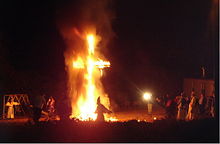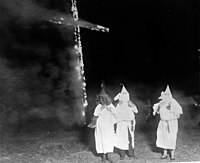Cross burning

Cross burning or cross lighting is a practice widely associated with the Ku Klux Klan, although the historical practice long predates the Klan's inception–as far back as Peter of Bruys (1117–1131), who burned crosses in protest of the veneration of crosses. In the early 20th century, the Klan burned crosses on hillsides or near the homes of those they wished to intimidate.
Scottish origins
In Scotland, the fiery cross, known as the Crann Tara, was used as a declaration of war.[1] The sight of it commanded all clan members to rally to the defense of the area. On other occasions, a small burning cross would be carried from town to town. It was used as recently as the War of 1812 to mobilise the Scottish Fencibles and militia settled in Glengarry County, Ontario against the invaders,[2] and in 1820 over 800 fighting men of Clan Grant were gathered, by the passing of the Fiery Cross, to come to the aid of their Clan Lord and his sister in the village of Elgin.[3] The most recent well-known use in Scotland itself was in 1745, during the Jacobite rising,[4] and it was subsequently described in the novels and poetry of Walter Scott.
The Birth of a Nation
In D.W. Griffith's The Birth of a Nation, the film adaptation of Thomas Dixon's novel, The Clansman, there are two examples of the burning of a cross. The first was when a former Confederate colonel's little sister had died by jumping off a cliff while being chased by a black captain who announced he wished to marry her and chased her when she refused. She finally threatened to jump off the cliff unless he stopped, and he pursued her. Her brother had held her in his arms at the bottom of the cliff, and she identified her attacker. This was in the setting that the Piedmont legislature had legalized interracial marriages. The small grouping of the clan burned a small cross, perhaps 8 inches tall, that had been drenched in the young girl's blood, and with the testimony of the colonel, based on the girl's dying words, there was a small trial, and the captain was found guilty of murder and executed. His body was placed on the front porch of the Governor of South Carolina's house with a square piece of white sheeting with the initials KKK.
The later incidents of the burning of a cross had been when it had been discovered that there were 2 home invasions, one being the home of the governor himself, when a black member of his government had proposed to his daughter and attempted to force the marriage by force of arms when she refused, and the governor himself and his home were held captive. The other home invasion was of the family of the Confederate colonel, whose mother had been found to be in sympathy of the Clan by making clan uniforms. There had also been military rule in the streets.
The colonel needed help from clans from neighboring counties. This was the second time the cross was burned, in daytime, this time creating a black smoke signal to call neighboring clans to come to their aid to give them the military power to overcome the military control of the town of Piedmont. The different clans wore different head-dresses and robes. They greeted each other with their faces uncovered although they drove into town with sheeting over their faces. The colonel had 2 adjacent square crosses on his robe, presumably from the original clan in Scotland.
Most notably, in the movie, the clans were plural. This is reinforced by the fact that Dixon's novel The Clansman uses a C and not a K.
Sign of the Ku Klux Klan

In the first era, reconstruction Klans did not burn crosses. The idea was introduced by Thomas Dixon, Jr., in his novel, The Clansman, in 1905. A cross burning is first described in Book IV Chapter 2 "The Fiery Cross" on pages 324–326 of the 1905 edition. It is introduced by one of the characters as "the old Scottish rite of the burning cross. It will send a thrill of inspiration to every clansmen in the hills." It is further elaborated that
In olden times when the Chieftain of our people summoned the clan on an errand of life and death, the Fiery Cross, extinguished in sacrificial blood, was sent by swift courier from village to village. This call was never made in vain, nor will it be to-night in the new world. Here, on this spot made holy ground by the blood of those we hold dearer than life, I raise the ancient symbol of an unconquered race of men—
This scene is accompanied by an unnumbered plate illustration by Arthur I. Keller, captioned "'The fiery cross of old Scotland's hills'", showing two robed, unmasked Klansmen over a bound, blindfolded and gagged African-American (accused of raping a white girl), one of whom is holding a lighted cross, while robed and hooded klansmen look on.[5] The novel ends with a klansmen waiting for election results stating "Look at our lights on the mountains! They are ablaze - range on range our signals gleam until the Fiery Cross is lost among the stars" meaning that he had won and civilization had been saved in the South.[6] The fiery cross is mentioned once again in the final novel of Dixon's Klan trilogy, The Traitor: A Story of the Fall of the Invisible Empire, when a Grand Dragon tosses a burning cross on a heap of discarded Klan robes and regalia in obedience to the order of the Grand Dragon to dissolve the order.[7] This scene is accompanied by an illustration captioned "Some of the men were sobbing" by Charles David Williams featuring a gathering of Klansmen over a burning pile of robes, carrying three burning crosses.[8]
The first instance of a cross being burned in the United States was on November 25, 1915, when a group led by William J. Simmons burned a cross on top of Stone Mountain, Georgia, inaugurating a revival of the Ku Klux Klan. The event was attended by 15 charter members and a few aging survivors of the original Klan.[9]
Crosses were burned during the Tallahassee bus boycott of 1956.[10]
Many Christians consider it sacrilege to burn or otherwise destroy a cross. Klan Christians, however, state that it is not destroying the cross, but "lighting" it, as a symbol of the members' faith.
Some Klan members & historians have claimed that the symbology behind the burning cross comes from Constantine the Great's vision of a burning cross, which then led to his conversion to Christianity.
Legal position in the United States
In Virginia v. Black (2003), the United States Supreme Court deemed constitutional a statute outlawing the public burning of a cross with intent to intimidate, but held that similar statutes that did not require showing of intent to intimidate were unconstitutional.
See also
References
- ^ Letters from Rupert's Land, 1826–1840: James Hargrave of the Hudson's Bay
- ^ Sketches Illustrating the Early Settlement and History of Glengarry in Canada.
- ^ "Archived copy". Archived from the original on 2008-01-13. Retrieved 2008-02-27.
{{cite web}}: Unknown parameter|deadurl=ignored (|url-status=suggested) (help)CS1 maint: archived copy as title (link). - ^ The Capital Scot. [dead link]
- ^ Dixon, Thomas, 1864–1946. Arthur I. Keller, illustr. The clansman; an historical romance of the Ku Klux Klan New York Doubleday, pages 324-327
- ^ Dixon, p. 374
- ^ Dixon, Thomas, 1864–1946 The traitor; a story of the fall of the invisible empire New York, Doubleday, Page & Company, 1907 p.53
- ^ Dixon, 1907 unnumbered plate between pp.52-3
- ^ "The Various Shady Lives of the Ku Klux Klan". Time magazine. April 9, 1965.
An itinerant Methodist preacher named William Joseph Simmons started up the Klan again in Atlanta in 1915. Simmons, an ascetic-looking man, was a fetishist on fraternal organizations. He was already a "colonel" in the Woodmen of the World, but he decided to build an organization all his own. He was an effective speaker, with an affinity for alliteration; he had preached on "Women, Weddings and Wives," "Red Heads, Dead Heads and No Heads," and the "Kinship of Kourtship and Kissing." On Thanksgiving Eve 1915, Simmons took 15 friends to the top of Stone Mountain, near Atlanta, built an altar on which he placed an American flag, a Bible and an unsheathed sword, set fire to a crude wooden cross, muttered a few incantations about a "practical fraternity among men," and declared himself Imperial Wizard of the Invisible Empire of the Knights of the Ku Klux Klan.
- ^ "Tallahassee Bus Boycott Timeline", Tallahassee Democrat, May 21, 2006, http://archive.tallahassee.com/legacy/special/boycott/timeline.html, retrieved 6/4/2025.
